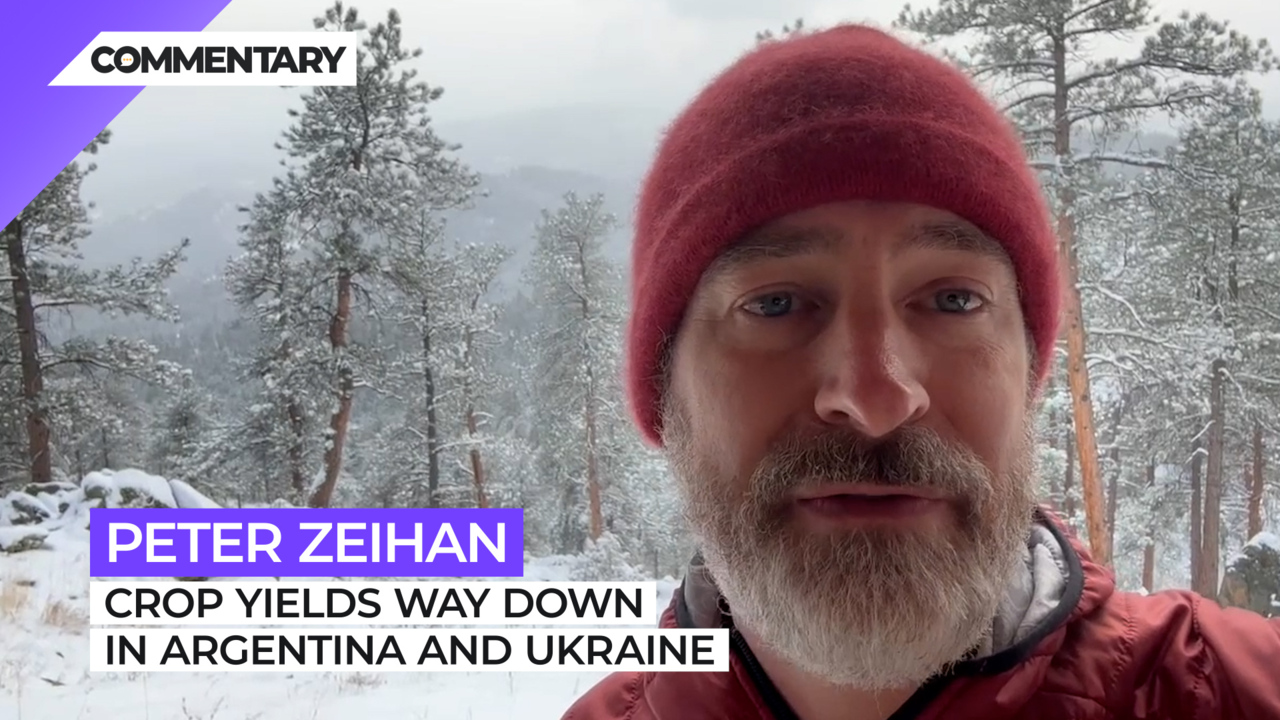
Commentary
-
Our commentary partners will help you reach your own conclusions on complex topics.
Hey Everybody, still Peter, still Colorado, still snowy, still foggy. Yesterday, we talked about the African swine fever problem in China and how it’s turning into an issue for fertilizer. I want to talk now about weather. We’ve got a number of major agricultural basins in the world. And last year for most of them, the Greater Midwest, the Brazilian-Argentine systems, South Africa, Australia-New Zealand, the Eurasian wheat belt, and Northern Europe, we had a pretty good year, pretty much everywhere. And even in secondary markets that aren’t export-oriented, like India and China, things were pretty good. That helped us a great deal, despite the fact that we were having a lot of scares and supplies coming out of the former Soviet space. But there’s two issues that we have already seen are going to be boiling up. The first one involves Argentina. Now, as a southern hemispheric country, they’re exiting summer and going into harvest right now. And between floods and droughts, and pestilence, and basically all the horsemen playing a role here, adding a general dollop of government incompetence, it’s shaping up to be one of the worst records for corn, soy and wheat that we have seen in years, with on average about a 30% reduction in the foodstuffs. Now 30%, that is a weather-induced reduction, not a fertilizer-induced reduction, so it could have been a lot worse. But we’re already seeing at the beginning of the 2023 harvest season, that we’re getting off to a really bad start. Australia so far looks. And then of course, India is harvesting things all the time. Now in the Northern Hemisphere, we don’t get our first crops in for a couple more months. And harvest will continue throughout the late spring for things like winter wheat and going into the summer and into the fall. So we have a lot of potential crops ahead of us. But to kind of kick off with Argentina, which is traditionally in the Big Six for wheat exports, and typically in the Big Three for soy exports, this is not a particularly auspicious start. The next major disruption I expect to see will be in Ukraine. We’ve all been seen through the winter that the Ukrainians have been suffering missile and drone attacks from the Russians who are trying to take up the power system, working from the theory that if you could knock out the electricity across Ukraine in the winter, you’re going to kill as many Ukrainians as possible and damage the morale of the war effort in general, because if you find out that your wife and kids back in Kyiv, don’t have power, it’s really hard to stay on the front. You feel like you should go and do something. Well, as we get into May, and especially June when it becomes apparent that knocking out the power doesn’t make anyone freeze to death anymore, the Russians are going to switch targets to go after the agricultural system, especially fertilizer plants, grain silos, grain transshipment locations at rail centers, ports and the rest. Already, we’re seeing the Russians backing away from the United Nations brokered deal that allows grain and corn and wheat and sunflower to get out of the system. Basically ships can come in, the Russians will search them on the way to make sure that they’re not carrying weapons, the Ukrainians will load them up with whatever foodstuffs they can export, and then we’ll be inspected by the Russians again, on the way out. It used to be that this deal was being renegotiated every 120 to 150 days, and the Russians want to shrink it down to 60 days, meaning that if this is renegotiated in March, it’s probably the last time it’s going to be renegotiated. Because the Russian goal here is to wipe out as many of Ukrainians as possible to make sure that they can’t fight. And that means taking the war to the civilian population. Electricity doesn’t work in the summer, so you go after the food supplies, which means that calendar year 2022 was probably the final year that Ukraine will be a significant agricultural exporter. Prewar roughly 85, in some cases, 90% of their ag products were shipped out by water with the rest going by rail. The problem is that the rail system in Ukraine doesn’t interface well with the rail system in Europe because it used different gauges. And you can only replace that and upgraded over the course of years. And it’s really hard to do when bombs are raining down. So we’re gonna get little trickles that go out of Western Ukraine that can take advantage of the rail. And that’s about it. And that’s of course, assuming that the Russians don’t achieve a breakthrough once they throw an extra 400,000 men into the fight come June. So we know we’ve already had a bad Argentine harvest and we know that the Ukrainians are probably going to fall off the map in terms of food supply. And honestly, that’s just the beginning. More in this in later issues.
-
Hurricane Helene hits US coast, Appalachia and beyond
Hurricane Helene hit Florida and Georgia overnight between Sept. 26 and 27 as a Category 4 hurricane, and accompanying storms will continue reaching deeper into the continental United States today. Dangerous flash flooding from the hurricane, known as storm surge, was some of the worst flooding that the Tampa Bay area has ever seen, and… -
Israel holds upper hand against Lebanon, Hezbollah and Iran
On Wednesday, Sept. 25, Hezbollah launched a ballistic missile at Tel Aviv in retaliation for Israel’s explosive pager attack that blew up devices across Lebanon. Although Israel’s defense systems intercepted the surface-to-surface missile, the attempted strike on Tel Aviv marked a significant escalation by Hezbollah. Since the siege on Gaza began, shortly after the Oct. 7, 2023,… -
The Sinaloa Cartel civil war
Fears of a civil war within the Sinaloa Cartel are growing as violence between competing factions within the cartel continues. The Mexican Army has dispatched around 600 elite troops to Sinaloa to help quell those fears, in addition to roughly 2,200 regular soldiers and National Guard. Watch the above video as Straight Arrow News contributor… -
New Ukrainian weapons hit Russia where it hurts
Ukrainian drones struck a major Russian ammunition depot, triggering a massive explosion that was captured on camera. According to the Ukrainian military, 2,000 tons of munitions had arrived at the depot before the attack. Over the past two years, Ukraine has significantly increased its domestic drone production, allowing it to scale up attacks on military… -
Weighing social costs vs. economic benefits on immigration
Global human migration is one of the defining elements of our current historical era, according to the United Nations. Migrants face both the incentives to leave — forced out by climate change, crime and corruption, extreme poverty or violence — and incentives for where to go, based on available job opportunities and so on. Migration…
Latest Stories
-
 Getty Images
Getty Images
Democrats want DOJ attorney who dropped Eric Adams case investigated
-
 Getty Images
Getty Images
Millions of users’ personal data shared with US law enforcement: Report
-
 Getty Images
Getty Images
Republican leaders urge a pause on town hall meetings
-
 Getty Images
Getty Images
Media spins Trump, Zelenskyy Oval Office meeting: Bias Breakdown
-
 Getty Images
Getty Images
Dems criticize Trump saying he’d lower prices on day 1: ‘S— ain’t true’
Popular Opinions
-
In addition to the facts, we believe it’s vital to hear perspectives from all sides of the political spectrum.
Latest Opinions
In addition to the facts, we believe it’s vital to hear perspectives from all sides of the political spectrum. We hope these different voices will help you reach your own conclusions.
The opinions published in this section are solely those of the contributors and do not reflect the views of Straight Arrow News.





















Latest Commentary
We know it is important to hear from a diverse range of observers on the complex topics we face and believe our commentary partners will help you reach your own conclusions.
The commentaries published in this section are solely those of the contributors and do not reflect the views of Straight Arrow News.
Dr. Frank Luntz
Pollster and Political Analyst‘Biased’: What Americans think of ‘mainstream media’
‘Getting rid of them’: Americans discuss Trump and immigration
‘Woke’: Why some Biden 2020 voters backed Trump in 2024